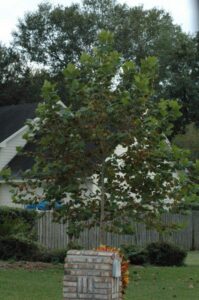S & J Nursery’s guide to growing
Sycamore Trees
in the Northeast Florida Landscape
( Platanus occidentalis )
Sycamore ( Platanus occidentalis )
Sycamore Origins:
– Native to North America
Sycamore Preferred Exposure:
– Full sun to light shade
Sycamore Foliage | Bark:
– Deciduous foliage of the Sycamore tree has three to five lobes and is
similar in appearance to a maple leaf except that it is a fair bit larger, up to 10 inches across, covering even the largest of human hands with all fingers outstretched.
– Sycamore foliage is a light green color and may turn a yellowish tan in fall
before falling off for the winter. ( not really a reliable source of fall color in our warm climate)
– Perhaps the Sycamore trees greatest asset is its white bark that peels off
in patches to reveal smooth new bark beneath adding a textural interest to the trees already showy large light green leaves.
– Sycamore seed pods are brown ball shaped clusters that hang on branches in the winter and are great for using in indoor fall decorations.
Sycamore Soil Preference / Salt tolerance:
– Tolerant of a wide range of soil conditions and a wide PH tolerance including highly alkaline. Great to plant into wet prolonged flood prone areas.
– Sycamore trees have only moderate salt tolerance, able to be used within a block or two from direct salt spray.
Sycamore / Platanus occidentalis Size Variance:
– can reach sizes of 70-90+ feet H | 50 -70+ feet W depending on how many
trunks are allowed to develop when young
Sycamore Growth Habit:
– upright narrow almost a Christmas tree shape when younger, taller than it is wide but spreading out to eventually form a more rounded appearance with age
Sycamore Growth Rate:
– extremely fast growth rate, perhaps the fastest growing shade tree for the
North Florida area landscape.
Sycamore / Platanus occidentalis Blooms:
– red inconspicuous bloom is followed by large ball shaped seed pods in winter that hang on bare branches.
Sycamore Water Requirements:
– Supplemental irrigation may be necessary in extremely well drained areas
Butterfly or Bird Attracting:
– n/a
Best Uses For Sycamore / Platanus occcidentalis:
– Sycamore trees are a good choice for poorly draining areas where room allows for the massive mature size of these trees. Also tolerant of high PH soils that cause problems for other trees.
– Allow plenty of room when planting as roots will cause damage to surrounding hardscape if planted to close.
Care of Sycamore:
– Water every day during the establishment period. See watering your newly planted trees for more information.
– They will need good water during the establishment period and supplemental irrigation during dry spells or particularly hot dry summers.
– Prune dead or weakened branches each summer as needed when young and thin branches to approximately 2 ft apart for best appearance.
– Provide a 1 ft diameter circle of mulched area where grass is kept from growing for each inch of caliper (or diameter) of trunk measured 4 inches from the ground level.
– Fertilize each spring with a mixture of milorganite and a slow release poly coated plant food such as Osmocote or Stay Green general purpose plant food, sprinkling the fertilizer around the mulch circle underneath the foliage of the tree

